Hospitality and Retail Go Green
Architectural Metalwork and HVAC Grille Specialties
When designing a green or sustainable building, the use of rating systems and standards helps in determining the degree to which different goals are achieved. While programs like LEED and WELL recognize different certification levels, allowing designers to pick and choose which attributes to pursue, full certification in the Living Building Challenge (LBC) requires that 100 percent of the building needs comply with the criteria. The LBC does allow recognition for individual petals that make up the total program, but all of the requirements for the petals must be met. The implication of this total approach is that everything in the design and/or specifications for a project needs to be looked at through the lens of a truly regenerative, healthy, and positive built environment. This can be easy to think of for the major components of a building such as structure, facades, finishes, etc., but total compliance means that it applies to specialty products too, such as accessories, trims, grilles, and similar items used in a building.
To illustrate this concept, let us take a look at a common and required product in most hospitality and retail buildings in the form of metal grilles, which cover HVAC openings or can be used for decorative and supporting purposes in walls, floors, and ceilings. Of course, there are choices in such products, and many come with a variety of attributes. They can offer a high-quality, custom product, giving architects and designers the freedom to design with luxury decorative metalwork and still be mindful that they are getting an environmentally friendly product. Aluminum is widely used in heating, ventilation, and air conditioning because of its resistance to corrosion and the extremes of heat and cold. It is also fully recyclable and can be reused time and time again with no loss in quality.
Green aluminum products are available for interior and exterior applications, which can provide a functional and aesthetic solution for architects and designers when trying to achieve certification for projects.
When used in a building pursuing LEED or LBC certification, architectural grilles need to be looked at and assessed on several fronts:
- Recycled metal content: Up to 94 percent post-consumer content recycled aluminum is possible and should be part of the specification for linear bar grilles, perforated grilles, or custom-fabricated products.
- Durability and ease of maintenance: The most sustainable product is one that lasts and does not need to be replaced or repaired unduly over time.
- Finishes: If any finish is used on the grilles, it needs to have low or zero volatile organic compound (VOC) content to qualify for a health-related certification. Some powder coatings that are electrostatically applied and then cured under heat without the use of solvents may be the best choice here.
Just like other products used in a building, the use of Declare labels issued by the International Living Future Institute can be asked for and used to compare different manufactured products based on the relevant criteria above. This information can be used for LBC projects, but note too that Declare has been approved as a compliance pathway for the LEED v4 Building Product Disclosure and Optimization Credit, Option 1. Regardless of the program being pursued, all products of all sizes and types used in a building need the transparent data and information that such declarations provide.
Edward Wawrynek, a customer service specialist with ARCHITECTURAL GRILLE, informs, “Manufacturers of metal specialties are committed to sustainability, responsibly sourcing recycled metals, and using environmentally friendly, non-Red List materials in our manufacturing processes. Some are able to meet Living Building Challenge requirements and are certified to provide eco-friendly grilles to hospitality and retail buildings or other projects.” Specifying accordingly improves the sustainability of hospitality buildings where they are used.
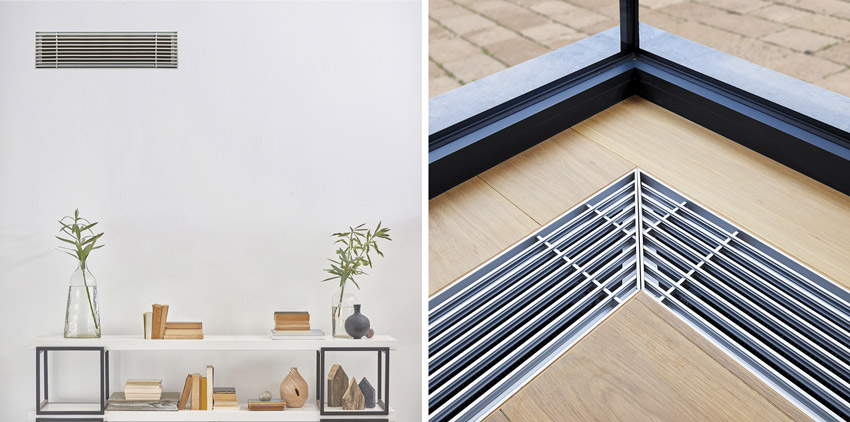
Photos courtesy of ARCHITECTURAL GRILLE
Aluminum HVAC grilles with 94 percent post-consumer recycled content used in green buildings or following the Living Building Challenge are as significant as any other building product when total compliance with standards is required.
Designing with Coiled Wire Fabric
In hospitality and retail settings, there may be a need to provide a degree of separation between different spaces without the use of a solid wall or partition. In fact, it may even be desirable to provide some controlled connectivity between spaces for visual, airflow, sound, or other reasons. A number of different products have been used to achieve this effect, particularly in interiors, but an emerging, innovative choice is the use of a coiled wire fabric. Such products are different from traditional metal mesh materials in that they are designed as architectural products for use in a variety of ways.
Coiled wire fabric is a durable, thin material that is lighter in weight than traditional wire mesh and offers more design flexibility. For interiors, architects and designers can use coiled wire fabric for curtains, ceiling treatments, wall coverings, security gates, and even as complete partitions, all adding elegance and purpose to spaces. On hospitality and retail exteriors, it can be used for sun shading, security protection, resilience enhancements, or aesthetic facade treatments. It is available with a range of attachment systems, allowing for different building conditions and finish treatments. The material can be left to hang (i.e., flowing freely) or secured at both the top and bottom and pulled taut to create a semi-rigid condition. Because of its fabric nature, curved and undulating shapes are easily achieved, providing interiors with more character and vitality than rectilinear shapes alone.
Coiled wire fabric can contribute to green building design in a number of ways. It has been tested and shown to be an easy and attractive way to save on air-conditioning costs by limiting the amount of sunlight entering the building. When used on the interior of windows, coiled wire fabric can reduce energy consumption by up to 5.7 percent and up to 21.3 percent when used for exterior shading scrim panels. Uniquely, the metal fabric does not block views to the outside like typical window curtains do. For retrofit applications where advanced high-performance glazing has not been installed, coiled wire fabric systems can be especially effective.
As a metal material, coiled wire fabric is a durable product with a long service life. It can contain recycled content and is 100 percent recyclable when it is removed from service. When used on building interiors, it is worth noting that no toxic chemicals are used in the material’s manufacturing process. Some even carry Declare labels, indicating the degree to which human health and the environment are protected by the products. Declare labels give consumers full transparency on the product, including where it comes from, what it is made of, and where it goes at the end of its life cycle.
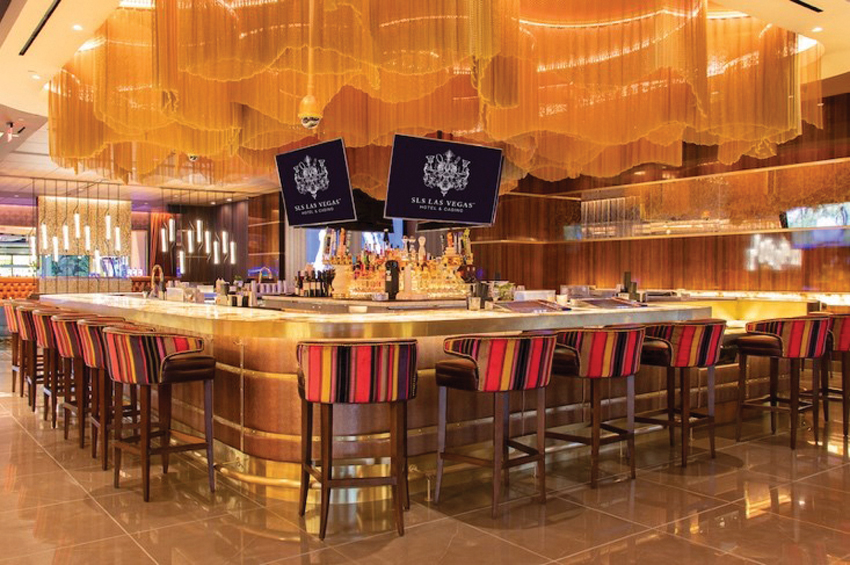

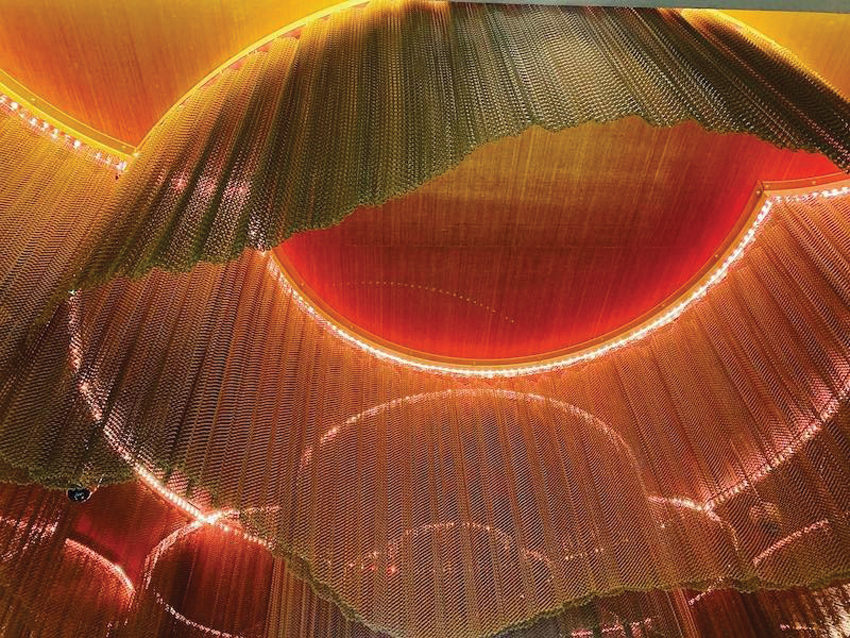
Photos courtesy of Cascade Architectural
The Casbar Lounge at the Sahara Hotel in Las Vegas uses coiled wire fabric to provide separation and connectivity between spaces while also acting as an artistic light screen.
Specifying Coiled Wire Fabric
When selecting a coiled wire fabric system for a hospitality or retail project, there are a lot of different choices in the details of how it can be specified. Following are some aspects to keep in mind when specifying and designing with this innovative material.
- Material makeup: Coiled wire fabric systems begin with a base metal wire in varieties of steel, aluminum, brass, copper, and stainless steel. The choice of the wire material and its gauge impact the weight, functionality, and aesthetics of the final fabric. By altering the base material, wire gauges, weave pattern, and finishes, the strength, rigidity, and appearance can all be chosen to meet thte design or performance characteristics being sought. It is worth noting that the fabric is available in virtually unlimited widths and up to 40 feet in length or height, so large installations can be achieved with a single panel in many cases. For projects needing more than a 40-foot span of fabric, multiple coils can be spliced together at the job site in a routine fashion and still create a continuous appearance.
- Light transparency: Coiled wire fabric will allow light to pass through, but how much and how visually transparent it appears will be based directly on the specified makeup of a particular fabric. Those with thicker wires and tighter weaves will allow less light than those with thinner wires and more open weaves. Architects and designers can vary the level of transparency by altering these factors to suit their needs. Fullness is another factor that designers can alter to vary the level of light able to pass through the coiled wire fabric. By using more material than what is required to cover a given area, a billowing drapery effect may be achieved, causing the mesh to overlap, which can be used to allow in more or less light.
- Formability: As with any fabric type of product, coiled wire fabric is free flowing and flexible. That means it can be formed and shaped to create undulating or curved surfaces, flat taut surfaces, or a combination of any of these. This allows for a high degree of creativity in how spaces are defined and articulated, both for walls and ceilings.
- Color: Coiled wire fabric is available in either a natural, uncoated state or with resilient powder-coating finishes for a sharp, long-lasting aesthetic. The color choices are broad, allowing it to be a successful part of virtually any design scheme. Further, the finishes can be specified with low VOC content or even Declare labels to protect human health when used on interiors.
- Performance traits: Coiled wire fabric can be used for light diffusion to further enhance the interior ambient lighting of a space. In appropriate strengths, it can provide partitioning for safety, fall protection, blast mitigation, and security. Further, if there is an interest in extending its use to the exterior, the material is durable enough to withstand those rigors as well.
- Cost-effectiveness: Compared to the full construction of rigid partitions or other separation elements, coiled wire fabric is a very affordable option. It is also more economical than commercial woven wire mesh that is typically designed for other purposes. This affordability lets architects and designers flex their creativity, produce signature interior designs, and turn projects with modest budgets into something unique, innovative, and responsive to project needs.
Designers who recognize the innovative uses of this product and its green building traits can achieve successful outcomes in hospitality and retail settings.
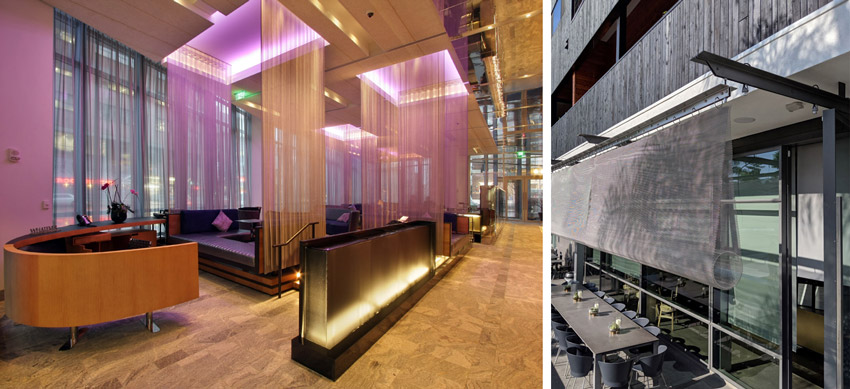
Photos courtesy of Cascade Architectural
At the W Hotel in Scottsdale, Arizona, coiled wire fabric is used both as an interior visual design element and an energy-saving sunscreen on windows. A typical exterior screen detail is shown as well.
Conclusion
Hospitality and retail facilities have the opportunity to demonstrate a wide variety of green and sustainable building practices. This is true when incorporating innovative ways to create and link indoor and outdoor spaces. It can make an impact in bathroom design and in prepackaging of the components of multiple bathroom units. Focusing on materials that use recycled metals in innovative ways assists in reducing the environmental footprint and achieving green building certifications. Overall, hospitality and retail buildings can be a big part of the modern green building movement.
Notice
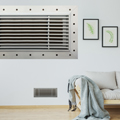
www.archgrille.com

www.bisonip.com

www.bradleycorp.com

www.cascade-architectural.com

www.kovaproducts.com

www.nanawall.com









